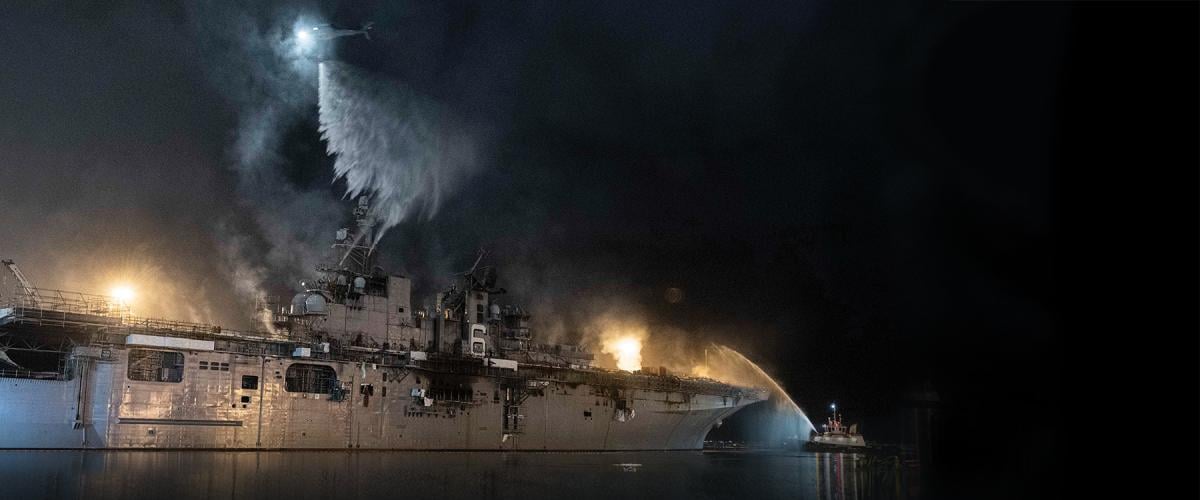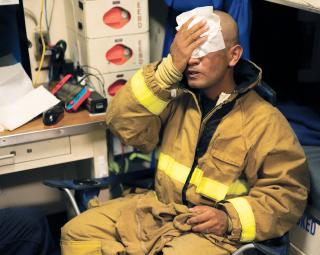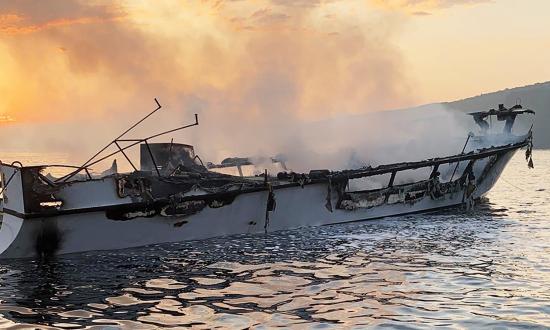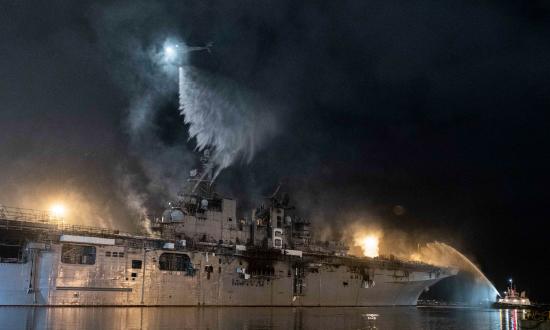As the loss of the USS Bonhomme Richard (LHD-6) and USS Miami (SSN-755) illustrate, in-port fires are more challenging than at-sea fires. At sea, a ship can muster every sailor within minutes of a fire’s ignition. In port, assuming eight-hour workdays and a two-day weekend, the full crew is present only about a quarter of the time (less after deducting crew members who are at schools, trainers, or riding other ships). Since 2008, 11 of 13 major in-port fires (identified by the Naval Safety Center), including those on the Miami and Bonhomme Richard, occurred outside normal working hours.1 Thus, only the duty section likely will respond to most in-port fires. Assuming four-section duty, this might be only a fifth of the entire crew—less for ships with more sections.2
At sea, ships assign specific sailors to fire response (surface ships use an at-sea fire party, also known as a “flying squad”) and designate senior leaders to take charge—typically the damage control assistant in a surface ship and the executive officer in a submarine. In short, a relatively small group of well-trained people fights at-sea fires. In port, however, this cadre of sailors is spread across the duty sections. Moreover, many of them likely stand watch on a supervisory watchbill, making their duty rotation even less frequent.
Fires also are more likely in port than at sea. Even minor maintenance availabilities involve “hot work” such as grinding and welding. Maintenance workers, whether Navy or civilian, also may not possess the same sensitivity to fire prevention as a ship’s crew or appreciate the risks in messy work sites or the improper stowage of flammable materials. It is no coincidence that since May 2008, only 2 major fires have occurred at sea, while there have been 13 major fires in port.3
Shipyard Firefighting
Ships in the shipyard face more challenges than other in-port ships because almost all normal systems may be secured for overhaul. For example, the shipyard often secures the ship’s fire main and replaces it with temporary firefighting hoses, which require training to use effectively. In addition, ventilation, lighting, and power systems are replaced with temporary ventilation ducts and cabling, often impeding passage through hatches, passageways, and doors.4 Surface ship firefighting entails establishing fire boundaries by closing all accesses to the affected space, which necessitates disconnecting these temporary cables and ducts. Although crews train on disconnecting these fittings on entering a maintenance availability, they often simulate this practice to avoid delaying shipyard work.5 And if the temporary ducts and cables are hung with flammable strapping, they will fall and block firefighters during a fire, which happened on board the Miami.6
Shipyards also secure ships’ normal intercom circuits and replace them with temporary communication systems that often are not as reliable or capable.7 The temporary system normally installed in submarines, for example, possesses a single point of failure and impedes the rapid flow of information.
Cleanliness and stowage suffer in the shipyard. Too often, crews accept that shipyard availabilities are industrial environments, with accompanying low standards for cleanliness. Even the best shipyards struggle to maintain cleanliness. Commanding officers also are more likely to accept unsafe conditions in industrial environments because of “production schedule and cost pressures.”8
Finally, some availabilities require ships to shift habitability off the ship and onto a barge or nearby barracks.9 As a result, the only people inside the ship at night might be a handful of roving and stationary watchstanders. This delays finding and responding to a fire, since the rest of the duty section must dash from the off-hull barge or barracks to reach the ship.
Ownership and Responsibility
A culture of fire prevention and safety starts with the right mindset: one of ownership and responsibility, regardless of the shipyard and external agencies. Some sailors believe that once a ship moors or enters a shipyard, they lose some responsibility for firefighting. This is a dangerous attitude. Sailors should expect help from the local fire department for an in-port fire, but no agreement or understanding ever relieves a crew of responsibility for their ship.10
Civilian fire departments are not prepared to fight a fire in a warship. Although they occasionally tour Navy ships, the ships are foreign territory. During the Miami fire, the federal fire department did not use the same terminology as the ship’s force, requiring impromptu translation between the crew and the firefighters.11 In the Bonhomme Richard, the San Diego Fire Department was the first agency to put water on the fire, yet fire attack efforts were hampered by the teams’ inability to find their way around the ship and the fact that their radios were not compatible with those of the federal fire department.12
Moreover, no matter how close the nearest fire department, it will take time for them to arrive. The critical time to extinguish a fire is in the first minutes, before it flashes over. By the time the fastest fire department arrives, if the crew has not adequately fought the fire, it will become a major fire involving multiple locations and decks.
The crew owns their ship. They should not expect anyone else to put out their fires.
Every Sailor a Firefighter
In-port and shipyard ships must immediately fight a fire with only the duty section. To ensure they can do this effectively, every sailor must be a firefighter.
This is not trivial. Becoming a proficient firefighter requires aptitude with fire hose vari-nozzles and thermal imagers, the ability to understand and react to hand signals from the thermal imager operator, and adeptness at routing, handling, and pressurizing fire hoses. Similarly, every rapid responder needs to don a self-contained breathing apparatus (SCBA) and fight the fire while awaiting teams dressed out in firefighting ensembles (FFEs). Donning a SCBA alone and expeditiously in a casualty environment requires practice.
To make every sailor a firefighter, ships must build firefighting proficiency across every watch team, starting with individual skills. This should include classroom training with thermal imagers, as well as “Damage Control Olympics” that race sailors against each other to don SCBAs and FFEs and hose-handling practice or routing races between duty sections. There are a variety of ways ships can provide dedicated firefighting training without relying on schoolhouses.
Ultimately, however, sailors should report to their ships with these skills, even if it means adding trainers and time to recruit and officer training pipelines and schools. The Navy should either develop a more realistic advanced firefighting trainer for damage control chief petty officers and submarine senior enlisted and officers or send these personnel to civilian fire academies. This training could encompass a more advanced study of fire science and prevention and involve extinguishing fires using numerous techniques and agents under conditions expected in a large fire: smoke, darkness, and equipment and wires on the deck or blocking accesses.13 Finally, the Navy should incorporate damage control knowledge and participation in performance evaluations.
Drill, Drill, Drill
Based on the results of various fire drills in recent years, most ships do not adequately simulate fires during drills.14 Fire drills should be as accurate as possible, which means they should occur in darkened spaces, with unexpected (and sometimes unknown) sources of fire, and should force personnel to deal with adversity such as injured firefighters. Also important, crews should train for very short in-hull stay times during a fire. High temperatures will exhaust firefighters, and SCBA air bottles will not last as long as under optimal conditions. Based on lessons from the Miami and Bonhomme Richard, 15 minutes is a reasonable time interval to rotate in a fresh firefighting team. This means that if a ship is in four- or six-section duty, everyone in the duty section, regardless of rank or rating, should be prepared to help battle the blaze.15
In addition, relying on the duty section to run and monitor its own drills does not work. Instead, ships should run drills with off-duty sailors available to provide simulation and monitor the responders. This requires a significant contribution from supervisors and off-duty personnel.
Crews also should practice integrating with external fire departments. Naval Sea Systems Command’s Industrial Ship Safety Manual for Fire Prevention and Response, also known as the 8010 manual, requires quarterly drills in which crews integrate with their local fire departments. These drills are valuable but also can be frustrating, as they reveal areas requiring more integration and planning. Because even federal shipyard fire departments are hard-pressed to allocate time and resources for additional integrated fire drills, some crews may practice integrating with their local fire department only a few times a year. This is insufficient to build the muscle memory of firefighting alongside an unfamiliar ally. The 8010 manual should be updated to require more integrated drills.
In the meantime, if an external fire department cannot participate in a ship’s drill, the next best thing is asking crewmembers from a nearby ship to help. The host ship might need to send a team member or two with the guest crew’s team to help direct their efforts and make sure the guest crew is adequately integrated into firefighting efforts. The time to figure out integration with other firefighters is not during a major fire or a major fire drill.
Finally, too many ships use inadequate drill simulations or take shortcuts when running fire drills, which can cost them during externally evaluated fire drills—or worse, an actual fire. The Navy should train drill coordinators specifically for the rigors of the shipyard. The difficulty and authenticity of in-port fire drills should be spot checked by the ship’s immediate superior in command or other waterfront training organizations.
Upgraded Firefighting Materiel
In the past ten years, the Navy has set dedicated damage control container express (ConEx) boxes near submarines in maintenance availabilities. These boxes contain FFEs, SCBAs, and additional damage control equipment. They are a good start, but more is needed. For example, some ships use their SCBAs for drills and then wait for the nearest fire station to recharge them because their own high-pressure air system is secured for shipyard maintenance (as was the case for the Bonhomme Richard) and the portable compressors’ charge rate is low.16 This sometimes takes a while, which results in ships simulating SCBA use. Every pier should have a filtered high-pressure air capability so ships can have SCBAs available for training at any time and to facilitate rapid recharging during casualties.
Because multiple agencies and ships respond to major shipyard fires, damage control shipyard kits should contain items such as additional thermal imagers, adapters that allow civilian fire departments to use their hoses with shipboard fire plugs, and additional radios and chargers. Given the superiority of modern thermal imagers, the Navy also should invest in new naval firefighting thermal imagers.17
Ships need more robust communication systems to not only alert crews to fires but also direct rapid responders.18 The Navy should supplement or replace single-point-of-failure communications with redundant temporary intercoms and more wirefree communication radios that have been proven on board countless ships and submarines. This would also improve coordination with fire departments, which use similar radios.19
Additional Recommendations
• Enforce higher cleanliness standards everywhere. As hard as it may be, Naval Sea Systems Command needs to “establish and enforce a much higher standard for shipboard cleanliness and stowage of both combustible and hazardous materials.” In addition, “commanding officers must be empowered to make difficult decisions to enforce the necessary fire safety posture, and then receive the necessary support to resolve any resulting shortfalls in production schedules and cost.”20
• Eliminate polyester-blend working uniforms. If the Navy takes the risk of in-port firefighting seriously, it should ditch, once and for all, any working uniform that is not flame retardant. During the Bonhomme Richard fire, a number of sailors, including chief petty officers, chose not to don FFEs and fight the fire because they thought (erroneously) that they could not do so while wearing type III Navy working uniforms.21
• Improve firefighting literacy. For the most part, sailors are all rookie firefighters. Shortly before the first explosion rocked the Bonhomme Richard, the San Diego Fire Department recognized a change in conditions and evacuated the ship.22 Given the Navy’s current level of experience and training, it is unlikely many sailors would have recognized the change and taken action. The Navy needs to promulgate more accessible firefighting manuals and additional engaging training materials such as movies.
There is no panacea for the challenge of in-port or shipyard firefighting. There is only hard work, tough training, and better support by the entire Navy. The Navy has lost two warships to in-port fires in the past ten years. It cannot lose more.
1. Commander, U.S. Fleet Forces Command, and Commander, U.S. Pacific Fleet, Major Fires Review Executive Summary (Department of the Navy, 15 July 2021), 16. The review examined 15 major fires, but 2 occurred while underway conducting normal operations.
2. Some ships are up to eight sections. VADM Scott D. Conn, USN, to Commander, U.S. Pacific Fleet, 5 April 2021, Memo N00/156, “Command Investigation into the Circumstances Surrounding the Fire Onboard USS Bonhomme Richard (LHD-6) on or about 12 July 2020,” Findings of Fact 554 (hereafter cited as Bonhomme Richard JAGMAN). See also Major Fires Review, 21.
3. Major Fires Review, 8, 10–11, 19.
4. Major Fires Review, 8.
5. Bonhomme Richard JAGMAN, Opinions 23, 92, 219.
6. Commander, Naval Sea Systems Command, to Distribution, 20 May 2013, Ser 00/C002, Subj: “Final Command Investigation into the Fire that Occurred Onboard USS Miami (SSN-755) at the Portsmouth Naval Shipyard on 23 May 2012,” Enclosure (1), Findings of Fact 148, 182. Hereafter cited as Miami JAGMAN.
7. Major Fires Review, 23, 26.
8. Major Fires Review, 23, 33.
9. Major Fires Review, 10.
10. Major Fires Review, 14, 25.
11. Miami JAGMAN, Findings of Fact 126, 146, Opinions 18.e.
12. Bonhomme Richard JAGMAN, executive summary, 9–11.
13. Major Fires Review, 57.
14. Major Fires Review, 27, 33.
15. Major Fires Review, 54.
16. Bonhomme Richard JAGMAN, Findings of Fact 420, 422, 462, 480, and 490; Opinions 13. This observation also is based on personal experience.
17. Major Fires Review, 51.
18. Major Fires Review, 51.
19. Miami JAGMAN, Opinions 18.d.
20. Major Fires Review, 46, 31.
21. Bonhomme Richard JAGMAN, Opinions 17, 208.
22. Bonhomme Richard JAGMAN, Findings of Fact 94.








